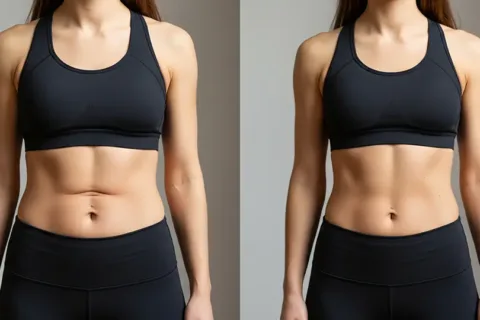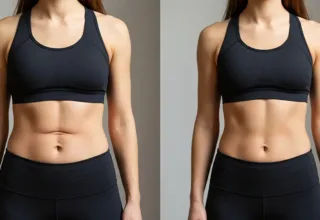Table of Contents
Are you reading this with your head craned forward, shoulders hunched, feeling that familiar ache creeping up your neck? You’re not alone. As a physiotherapist, I see hundreds of patients every month suffering from what we call “tech neck” – and today I’m sharing 5 physiotherapist’s secret: 5-minute desk stretches for instant neck pain relief that actually work. The solution might be simpler than you think.
After treating countless desk workers, remote employees, and computer professionals over the past decade, I’ve discovered something remarkable: you don’t need expensive treatments or hours of therapy to get instant neck pain relief. The secret lies in a targeted 5-minute routine that addresses the root cause of your discomfort and can be done anywhere, anytime.
The Modern Epidemic: Understanding Tech Neck
Tech neck has become one of the most common complaints in my practice, affecting an estimated 60% of office workers worldwide. This isn’t just a minor inconvenience – it’s a serious musculoskeletal condition that can lead to chronic pain, reduced productivity, and long-term spinal problems if left untreated.

The statistics are staggering: The average person spends 7-10 hours per day looking at screens, with their head in a forward position for 60-70% of that time. This prolonged poor posture creates a cascade of problems throughout your entire upper body.
What Exactly Is Tech Neck (And Why Your Neck Is Screaming for Help)
Tech neck, also known as “forward head posture” or “computer neck syndrome,” occurs when your head shifts forward from its natural alignment over your shoulders. This seemingly small change has massive consequences for your neck muscles, joints, and overall spinal health.

The biomechanics are simple but devastating: For every inch your head moves forward, it effectively doubles the weight your neck muscles must support. The average human head weighs 10-12 pounds in neutral position. When you’re looking down at your phone or hunched over your laptop, that weight can feel like 20-40 pounds to your neck muscles. Imagine carrying a bowling ball on your shoulders all day – that’s exactly what your neck is dealing with.
The Hidden Costs of Poor Posture
Beyond the obvious neck pain, tech neck creates a domino effect of problems throughout your body:
Cervical Spine Compression: Forward head posture compresses the vertebrae in your neck, potentially leading to disc problems and nerve impingement.
Reduced Lung Capacity: Poor posture can reduce your lung capacity by up to 30%, affecting your energy levels and cognitive function.
Increased Stress Hormones: Chronic pain from tech neck elevates cortisol levels, impacting your sleep, mood, and immune system.
Decreased Productivity: Studies show that employees with neck pain are 23% less productive and take 40% more sick days than their pain-free counterparts.
Comprehensive Symptoms of Tech Neck
While neck pain is the most obvious symptom, tech neck manifests in numerous ways:
Primary Symptoms:
- Stiffness and soreness in the neck and shoulders
- Headaches, especially at the base of the skull
- Upper back pain between the shoulder blades
- Reduced range of motion when turning your head
- Muscle spasms in the neck and upper trapezius
Secondary Symptoms:
- Shoulder impingement and rotator cuff problems
- Numbness or tingling in the arms and hands
- Jaw pain and temporomandibular joint (TMJ) dysfunction
- Chronic fatigue and difficulty concentrating
- Sleep disturbances and morning stiffness
Long-term Consequences:
- Cervical disc degeneration
- Chronic tension headaches
- Thoracic kyphosis (rounded upper back)
- Increased risk of cervical spine arthritis
5 Physiotherapist’s Secret: The 5-Minute Physiotherapist-Approved Desk Stretch Routine
This routine targets the specific muscles that become tight and weak due to prolonged desk work. You can do these stretches right at your desk, in your work clothes, without breaking a sweat. Each exercise has been carefully selected based on biomechanical research and clinical effectiveness.
Stretch 1: The Chin Tuck Reset (60 seconds)
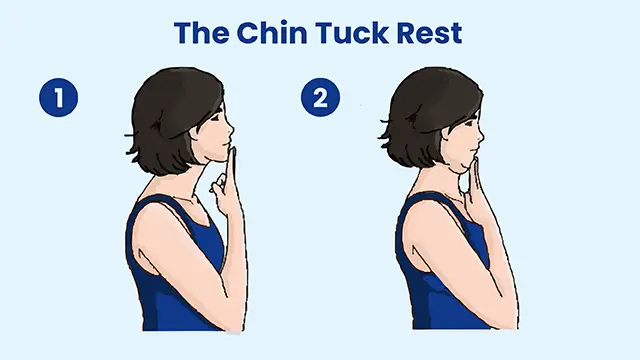
What it does: Reverses forward head posture and activates deep neck flexors while stretching the suboccipital muscles.
The science: This exercise targets the deep cervical flexors, which become inhibited in forward head posture. Strengthening these muscles is crucial for maintaining proper cervical alignment.
How to do it:
- Sit tall with your back against your chair, feet flat on the floor
- Look straight ahead, keeping your eyes level with the horizon
- Gently draw your chin back, creating a “double chin” sensation
- You should feel a gentle stretch at the base of your skull
- Hold for 5 seconds, then relax completely
- Repeat 10-12 times, focusing on smooth, controlled movements
Pro tip: Imagine you’re being pulled up by a string from the top of your head while simultaneously pushing your chin back. This helps maintain proper spinal alignment throughout the exercise.
Common mistakes:
- Tilting your head up or down while retracting
- Forcing the movement too aggressively
- Holding your breath during the exercise
Progression: Once you master the basic movement, try holding the position for 10 seconds or performing the exercise while standing against a wall.
Stretch 2: Upper Trap Stretch (90 seconds – 45 seconds each side)
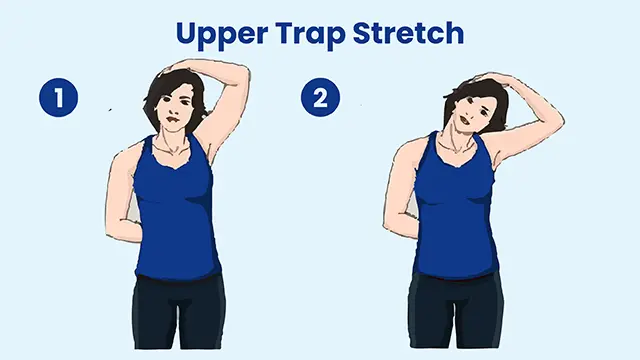
What it does: Releases tension in the upper trapezius muscles that become overactive with poor posture and contribute to shoulder elevation.
The science: The upper trapezius becomes chronically tight in forward head posture as it compensates for weak deep neck flexors. This stretch helps restore normal muscle length and reduces trigger point formation.
How to do it:
- Sit upright with your spine in neutral alignment
- Place your right hand under your right thigh to anchor your shoulder
- Gently tilt your head to the left, bringing your left ear toward your left shoulder
- Use your left hand to apply gentle, sustained pressure to the right side of your head
- Hold for 45 seconds, breathing deeply throughout
- Slowly return to center and switch sides
- Repeat the entire sequence once more for maximum benefit
Feel it: You should feel a gentle pull along the right side of your neck and shoulder. The stretch should be comfortable, not painful.
Breathing technique: Inhale to prepare, exhale as you deepen the stretch. This helps activate your parasympathetic nervous system and enhances muscle relaxation.
Variations:
- For a deeper stretch, look slightly away from the side being stretched
- Add gentle neck rotation to target different muscle fibers
- Use a resistance band for proprioceptive feedback
Stretch 3: Levator Scapulae Stretch (90 seconds – 45 seconds each side)
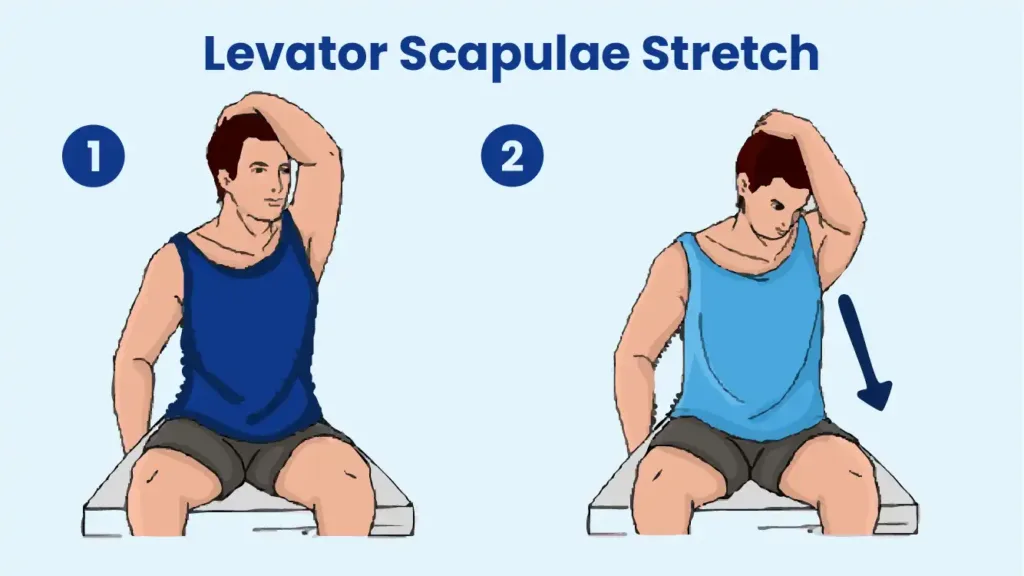
What it does: Targets the muscle that connects your neck to your shoulder blade, often the culprit behind that persistent “knot” feeling between your neck and shoulder.
The science: The levator scapulae becomes shortened and develops trigger points due to sustained shoulder elevation during computer work. This stretch helps restore normal muscle length and reduces referral pain patterns.
How to do it:
- Turn your head 45 degrees to the left (halfway between looking straight and looking over your shoulder)
- Look down as if you’re looking into your left armpit
- Place your left hand on the back of your head, fingers interlaced
- Gently pull downward, feeling the stretch along the right side of your neck
- Hold for 45 seconds, maintaining steady breathing
- Slowly release and repeat on the right side
Advanced technique: For enhanced effectiveness, try the “contract-relax” method: gently resist the stretch for 5 seconds, then relax and deepen the stretch for the remaining time.
Common mistake: Don’t pull too hard – this should feel like a gentle stretch, not painful. Aggressive stretching can cause protective muscle guarding.
Anatomical focus: This stretch specifically targets the levator scapulae’s attachment from the transverse processes of C1-C4 to the superior angle of the scapula.
Stretch 4: Doorway Chest Stretch (60 seconds)
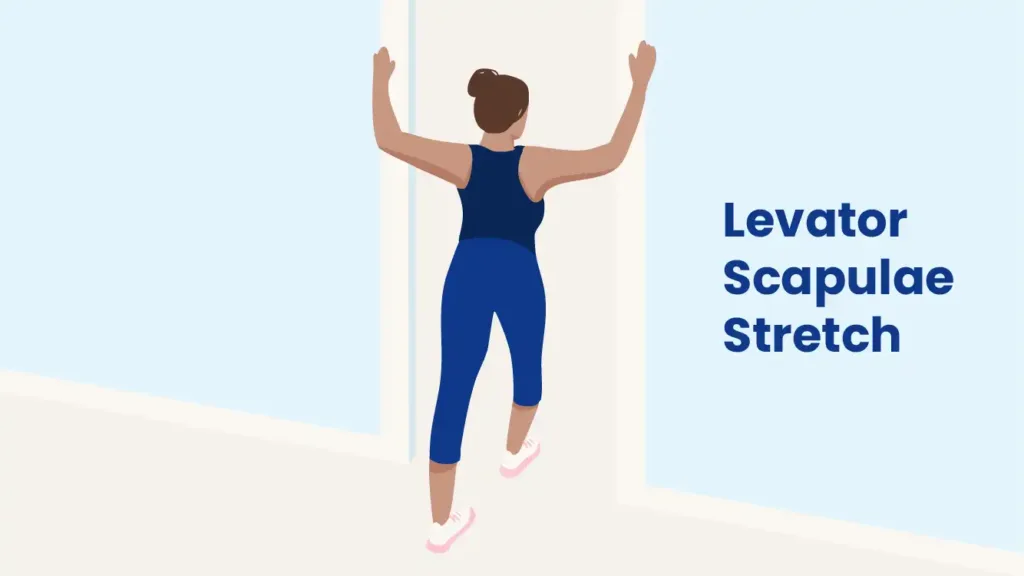
What it does: Opens up the chest muscles (pectoralis major and minor) that become tight from hunching forward, helping to restore proper shoulder alignment.
The science: Tight chest muscles create internal rotation of the shoulders and contribute to forward head posture. This stretch helps restore the length-tension relationship in the anterior chain.
How to do it:
- Stand in a doorway with your forearm flat against the door frame
- Your elbow should be at 90 degrees, level with your shoulder
- Step forward with the opposite foot, feeling a stretch across your chest
- Hold for 30 seconds, then switch arms
- For a deeper stretch, raise your arm higher on the door frame
- Repeat the sequence with your arm at different heights (low, middle, high)
Why it matters: Tight chest muscles pull your shoulders forward, contributing to tech neck by creating a forward head posture compensation pattern.
Breathing focus: Take deep breaths during this stretch, as it also helps expand your ribcage and improve respiratory function.
Modification for office: If you don’t have a doorway available, use a corner wall or perform the stretch by clasping your hands behind your back and lifting them away from your body.
Stretch 5: Shoulder Blade Squeeze (60 seconds)
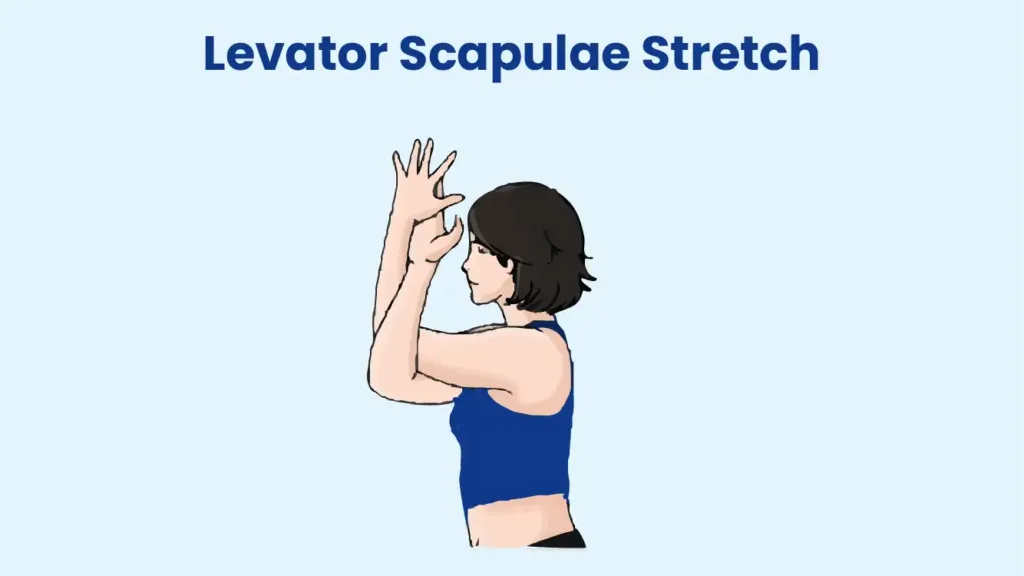
What it does: Strengthens the muscles between your shoulder blades (middle trapezius and rhomboids) that become weak with poor posture, while improving postural awareness.
The science: These muscles become weak and inhibited in forward head posture, contributing to rounded shoulders and thoracic kyphosis. Strengthening them helps restore proper scapular positioning.
How to do it:
- Sit tall with your arms at your sides, palms facing forward
- Squeeze your shoulder blades together as if you’re trying to hold a pencil between them
- Focus on pulling your shoulder blades down and back, not just together
- Hold for 5 seconds, feeling the muscles between your shoulder blades contract
- Relax completely for 2 seconds
- Repeat 10-12 times with perfect form
Visualization: Think about tucking your shoulder blades into your back pockets while simultaneously lifting your chest.
Progressive loading: Start with bodyweight resistance, then progress to using light resistance bands or weights as your strength improves.
The Science Behind Why These Stretches Work
These stretches target what we call the “upper crossed syndrome” – a pattern of muscle imbalances first described by Dr. Vladimir Janda. This syndrome is characterized by a predictable pattern of tight and weak muscles that develops in response to prolonged poor posture.
Tight/Overactive Muscles:
- Upper trapezius and levator scapulae
- Pectoralis major and minor
- Suboccipital muscles
- Sternocleidomastoid
Weak/Inhibited Muscles:
- Deep neck flexors
- Middle and lower trapezius
- Serratus anterior
- Rhomboids
The Neurological Component: These stretches don’t just address muscle tightness – they also help reprogram your nervous system’s postural control mechanisms. Regular practice helps restore proper proprioception (body awareness) and motor control patterns.
Research Evidence: Multiple studies have shown that targeted stretching programs can reduce neck pain by 40-60% within 4-6 weeks. The key is consistency and proper technique.
Advanced Techniques for Maximum Effectiveness
The Myofascial Connection
Your muscles are surrounded by fascia – a connective tissue network that can become restricted with poor posture. To maximize the benefits of these stretches, consider incorporating myofascial release techniques:
Self-massage techniques:
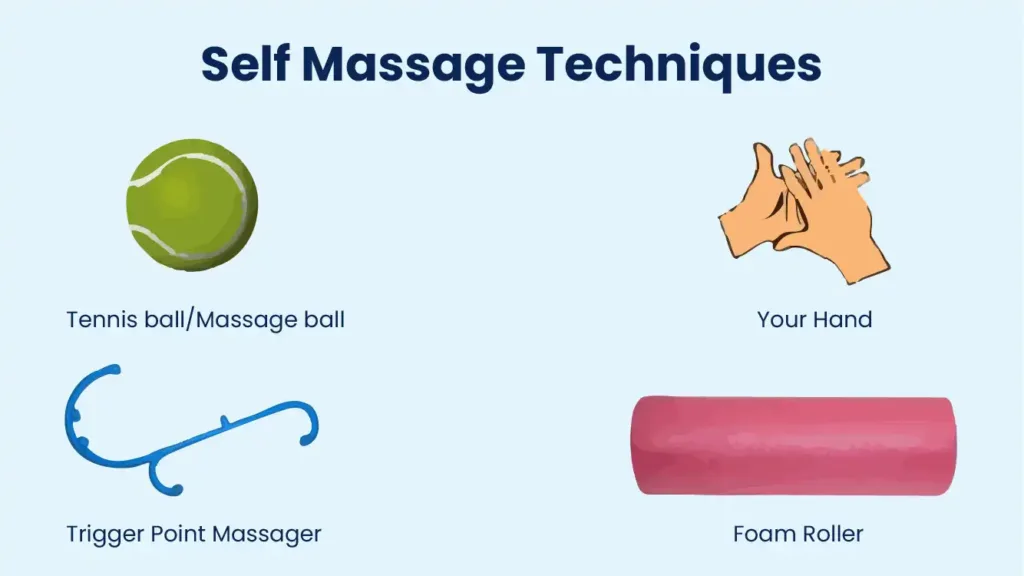
- Use a tennis ball against a wall to release trigger points in your upper back
- Gently massage your neck muscles with your fingertips in circular motions
- Apply pressure to tender spots for 30-60 seconds to release tension
Progressive Overload for Stretching
Just like strength training, stretching benefits from progressive overload:
Week 1-2: Hold each stretch for the prescribed time, focusing on proper form Week 3-4: Increase hold time by 15-30 seconds per stretch Week 5-6: Add second sets of each stretch Week 7+: Incorporate proprioceptive neuromuscular facilitation (PNF) techniques
Timing Is Everything
Morning Protocol (5 minutes): Do this routine when you first sit down at your desk to prepare your body for the day ahead.
Midday Reset (3 minutes): Perfect for that afternoon slump when tension builds. Focus on the chin tucks and upper trap stretches.
Evening Decompression (7 minutes): Extend the routine with longer holds to help decompress after a long day.
Micro-breaks (30 seconds): Every 30 minutes, perform quick chin tucks and shoulder blade squeezes.
Creating Sustainable Habits
The 21-Day Challenge
Research shows it takes approximately 21 days to form a new habit. Here’s how to make these stretches part of your daily routine:
Days 1-7: Set hourly reminders on your phone to perform the routine Days 8-14: Link the stretches to existing habits (after checking email, before lunch) Days 15-21: Focus on consistency over perfection – missing one day won’t derail your progress
Technology Solutions
Apps to consider:
- Posture reminder apps that use your device’s camera
- Stretching apps with guided routines
- Ergonomic assessment tools
Wearable devices: Some fitness trackers now include posture monitoring features that can remind you to check your alignment.
Environmental ModiFications
Ergonomic workspace setup:
- Monitor at eye level, arm’s length away
- Keyboard and mouse at elbow height
- Chair supporting natural lumbar curve
- Feet flat on floor or footrest
Lighting considerations: Poor lighting forces you to crane your neck forward. Ensure adequate, properly positioned lighting to maintain good posture.
When to Seek Professional Help
While these stretches are highly effective for most people, you should consult a physiotherapist if:
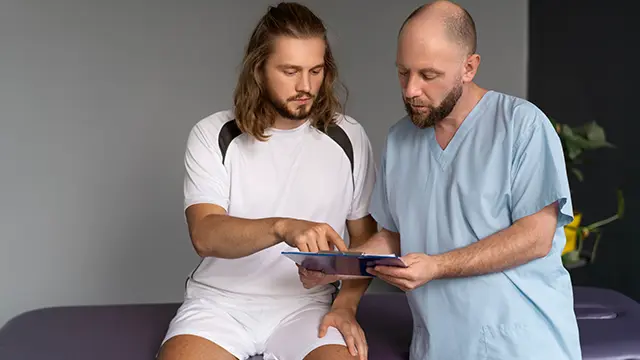
- Your symptoms persist after 2-3 weeks of consistent stretching
- You experience numbness or tingling in your arms or hands
- You have severe headaches or dizziness
- Your neck pain is accompanied by fever
- You’ve had a recent injury or accident
- Your pain is getting worse despite stretching
Red Flags Requiring Immediate Medical Attention
Seek emergency care if you experience:
- Severe neck pain following trauma
- Numbness or weakness in both arms
- Difficulty swallowing or speaking
- Fever with neck stiffness
- Severe headache with neck pain
Comprehensive Prevention Strategies
The 20-20-20 Rule Plus
The classic 20-20-20 rule (every 20 minutes, look at something 20 feet away for 20 seconds) is a good start, but here’s the enhanced version:
20-20-20-20 Rule:
- Every 20 minutes
- Look at something 20 feet away
- For 20 seconds
- Perform 20 chin tucks
Movement Variability
Desk-based movements:
- Alternate between sitting and standing every 30 minutes
- Use a stability ball for 15-20 minutes of your workday
- Perform neck circles and shoulder rolls every hour
- Take walking meetings when possible
Sleep Positioning
Your pillow choice significantly impacts your neck health:
For side sleepers: Use a pillow that keeps your neck aligned with your spine For back sleepers: Choose a thinner pillow that doesn’t push your head forward For stomach sleepers: (Not recommended) Use a very thin pillow or none at all
Long-term Management and Maintenance
Progressive Exercise Program
As your neck health improves, consider advancing to more challenging exercises:
Weeks 1-4: Focus on the basic 5-minute routine Weeks 5-8: Add resistance band exercises for neck strengthening Weeks 9-12: Incorporate dynamic movement patterns Months 4-6: Progress to functional movement training
Lifestyle Modifications
Stress management: Chronic stress contributes to muscle tension. Consider yoga, meditation, or deep breathing exercises.
Hydration: Dehydration affects muscle function and recovery. Aim for adequate water intake throughout the day.
Sleep quality: Poor sleep impacts muscle recovery and pain perception. Prioritize 7-9 hours of quality sleep.
Regular Assessment
Monthly check-ins:
- Assess your pain levels on a 1-10 scale
- Measure your neck range of motion
- Evaluate your posture in photos
- Adjust your routine based on progress
The Bottom Line: Small Changes, Big Results
Tech neck didn’t develop overnight, and it won’t disappear overnight either. But with consistent application of this 5-minute routine, most of my patients report significant improvement within just one week. The key is understanding that this isn’t just about stretching – it’s about retraining your entire postural system.
The beauty of this approach lies in its simplicity and accessibility. You don’t need special equipment, a gym membership, or even to leave your desk. What you do need is consistency and the commitment to prioritize your neck health.
Remember, your neck supports your head – literally your most important asset. The average person’s head weighs as much as a bowling ball, and your neck muscles work tirelessly to support it. Isn’t it worth five minutes of your day to keep it healthy and pain-free?
The compound effect is real: These small, daily investments in your neck health will pay dividends in reduced pain, improved productivity, better sleep, and enhanced quality of life. My patients often report that these simple stretches have been life-changing, allowing them to work longer, sleep better, and enjoy activities they thought they’d have to give up.
Ready to Transform Your Neck Health?
Start implementing this routine today, and don’t forget to track your progress! Take photos of your posture, rate your pain levels, and note any improvements in your daily activities. Your neck (and your productivity) will thank you.
The journey to better neck health starts with a single stretch. Make today the day you take control of your posture and reclaim your comfort. Your future self will thank you for the investment you make today.
Have questions about these stretches or dealing with persistent neck pain? As a licensed physiotherapist with over a decade of experience treating tech neck, I’m here to help you achieve lasting relief and optimal neck health. [Book a consultation today] to develop a personalized treatment plan that addresses your specific needs and lifestyle factors.
Disclaimer: This information is for educational purposes only and should not replace professional medical advice. Always consult with a healthcare provider before beginning any new exercise routine, especially if you have existing health conditions. Individual results may vary, and consistency is key to achieving optimal outcomes.
FAQs (Frequently Ask Questions)
How long does it take to see results from desk stretches for neck pain?
Most people experience some relief immediately after performing these stretches, with significant improvement typically seen within 7-10 days of consistent daily practice. For chronic tech neck, full recovery may take 4-6 weeks of regular stretching combined with ergonomic improvements.Lorem ipsum dolor sit amet, consectetur adipiscing elit. Ut elit tellus, luctus nec ullamcorper mattis, pulvinar dapibus leo.
Can I do these neck stretches every day?
Yes, these gentle stretches are designed for daily use and can be performed multiple times throughout your workday. In fact, consistency is key – performing them 2-3 times daily will yield better results than doing them occasionally.
What is tech neck and how do I know if I have it?
Tech neck (forward head posture) occurs when your head shifts forward from prolonged screen use. Common symptoms include neck stiffness, headaches, shoulder pain, and reduced range of motion when turning your head. If you experience these symptoms after computer work, you likely have tech neck.
Are these stretches safe to do at work?
Absolutely! These stretches are specifically designed to be performed in business attire at your desk without causing sweating or requiring floor space. They’re gentle, professional, and effective for office environments.
How often should I do desk stretches during my workday?
Ideally, perform the complete 5-minute routine every 2-3 hours, with quick 30-second chin tucks and shoulder blade squeezes every 30 minutes. This prevents muscle tension from building up throughout your workday.
Can desk stretches replace physiotherapy treatment?
While these stretches are highly effective for mild to moderate tech neck, severe or persistent symptoms may require professional physiotherapy treatment. If pain persists after 2-3 weeks of consistent stretching, consult a physiotherapist.
What's the best time of day to do neck stretches?
The routine works well at any time, but many find it most beneficial first thing in the morning to prepare for the workday, at midday to reset posture, and in the evening to decompress from daily tension.
Do I need any equipment for these desk stretches?
No special equipment is required! All stretches can be performed using just your desk chair and a doorway. This makes them perfect for any office environment or home workspace.
Why do I get neck pain from computer work?
Computer work causes tech neck because your head shifts forward to view the screen, forcing your neck muscles to support 2-3 times your head’s normal weight. This prolonged poor posture creates muscle imbalances and tension.
Can these stretches help with headaches caused by neck tension?
Yes! Many tension headaches originate from tight neck and shoulder muscles. The chin tuck and upper trap stretches specifically target muscles that commonly refer pain to the head, providing headache relief.


